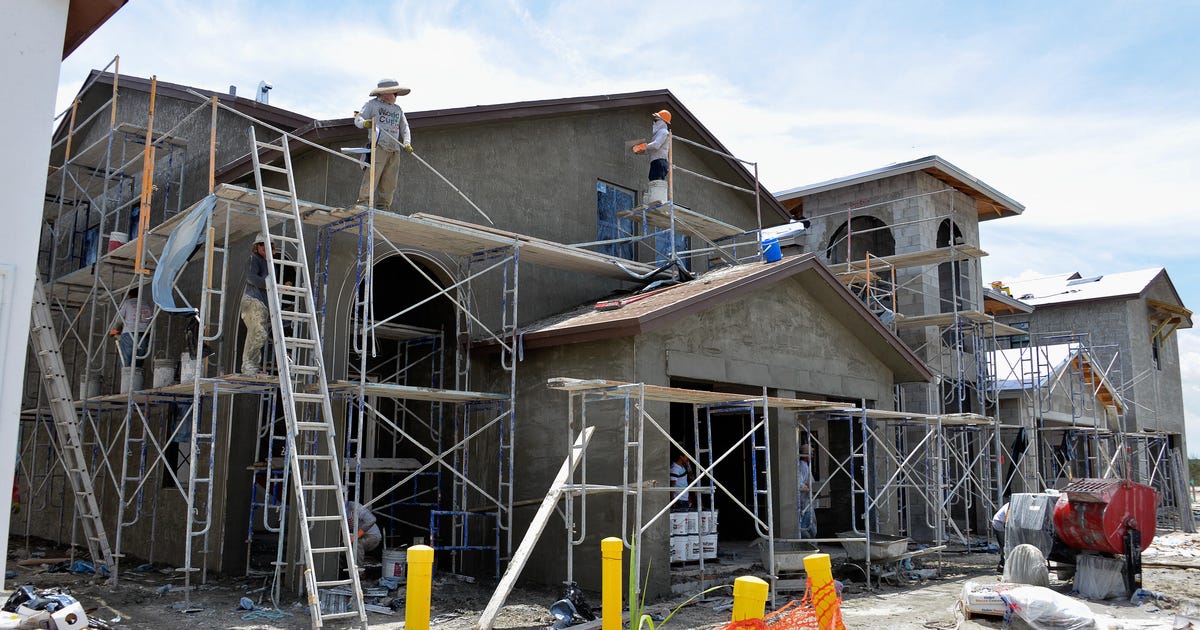The average mortgage rates, including 30-year, 15-year, jumbo 30-year, and refi mortgages, have risen to new record levels, with the 30-year fixed-rate averaging at 7.80%.
U.S. mortgage rates have increased for the fifth consecutive week, with the 30-year reaching its highest level since 2001, indicating ongoing economic strength and a potential decrease in existing home sales.
Mortgage rates have increased recently due to inflation and the Federal Reserve's interest rate hikes, but experts predict rates will remain in the 6% to 7% range for now; homebuyers should focus on improving their credit scores and comparing lenders to get the best deal.
Rates on 30-year fixed-rate mortgages rose Thursday following three straight days of declines, while most other loan types experienced small or moderate gains but still have a way to go before recovering from recent losses.
Mortgage rates for most types remained steady or experienced minimal changes, with the 30-year mortgage average dropping slightly, but still above its recent low, indicating that it's still a good idea to compare rates when seeking a mortgage.
Mortgage rates have slightly decreased from their peak in late August, but future trends will depend on the economy and inflation rates, with potential decreases if inflation slows and the Federal Reserve stops increasing its benchmark rate.
Mortgage rates for home purchases and refinancing have fluctuated, with rates for 30-year terms increasing and rates for 10-year and 15-year terms decreasing. Borrowers have the option to choose a term that aligns with their financial goals and preferences.
High mortgage rates have frozen the US housing market, but experts predict that the Federal Reserve may cut interest rates in the next 12 to 18 months, potentially leading to a decline in mortgage rates.
Mortgage rates have increased recently due to the Federal Reserve's interest rate hikes, and there is a possibility of further rate increases if inflation persists, so homebuyers are advised to focus on getting the best rate for their financial situation.
US mortgage rates reached their highest level in nearly 23 years, with the 30-year fixed-rate mortgage averaging 7.31%, up from 7.19% the previous week, due to persisting inflation pressures.
Mortgage demand hits a 28-year low as long-term mortgage rates soar above 7%, leading to a slowdown in homebuying activity and applications to refinance, while adjustable-rate mortgages become more popular.
Mortgage rates have reached a 23-year high, causing a decline in homebuyer demand and an increase in lower-rate options, with the possibility of rates hitting 8% this year.
The average rates for fixed mortgages continue to rise as demand for adjustable loans increases due to high monthly payments and affordability constraints in the housing market.
High mortgage rates are expected to fall over the next year, with rates projected to decrease to 6.1% by the end of 2024 and the 30-year mortgage rate falling to 5.5% by the end of 2025, driven by a slowing U.S. economy and signs of a weakening economy, according to the Mortgage Bankers Association.
Mortgage rates dropped at the end of the week, with the 30-year fixed-rate average at 8.07%, significantly lower than the previous week's historic high of 8.34%.
Average 30-year mortgage rates are expected to trend down in the next few months, but more substantial drops are not likely until next year, making the end of 2024 a better time for potential homebuyers to start the process, while current homeowners may have an opportunity to refinance in the next year or two.
The interest rate on a 30-year fixed-rate mortgage is 8.000% as of October 16, 2023, which is 0.500 percentage points lower than it was on Friday, and it's important to compare different lenders' current interest rates, terms, and fees to ensure you get the best deal.
Mortgage rates in the US have reached their highest levels in over 20 years, with the average interest rate on a 30-year fixed rate home loan rising to 8%, as the Federal Reserve raises interest rates to combat inflation and demand for US government debt fluctuates. The increase in mortgage rates has already affected the housing market, with sales of existing homes down 15% compared to last year, although house prices have remained high due to strong demand.
The average 30-year mortgage rate surged to 8%, driven by a climb in the 30-year Treasury bond yield to its highest point in 17 years, leading to a substantial decline in mortgage loan applications.
